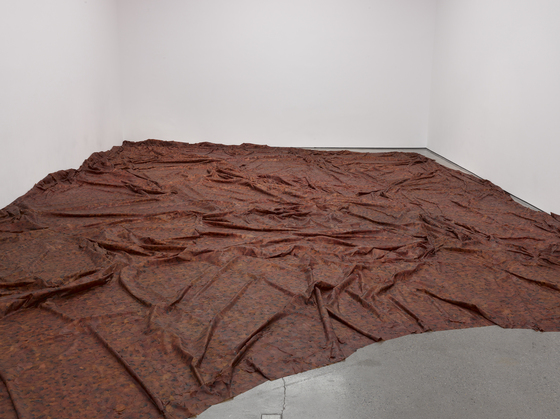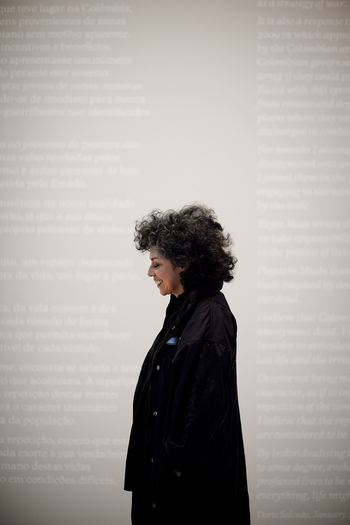Doris Salcedo: Where Lives are More Than Data @ The Museum of Contemporary Art (original) (raw)
Art Mon Feb 23 2015
The commotion (and borderline hysteria) over the recent David Bowie exhibition [PDF] at the Museum of Contemporary Art in January has ceased -- the elaborate costumes and platform boots have bid adieu to Chicago and are traveling across the ocean into another realm of dreaminess and glamor.
The aura, subsequently, has changed. Visually powerful, elegantly arranged, and rich with conversation, the museum has welcomed sculptor Doris Salcedo in a retrospective that spans her 30-year career. The Colombian artist's exhibition opened Feb. 21 and will be on view until May 24.
Salcedo, a public-works artist, has transformed the fourth floor of the MCA into an installation that urges viewers and visitors to slow down, meditate, and remember the lives that she chooses to commemorate. Each death and each disaster draws Salcedo into a creative process involving found objects, every-day materials, and findings from the earth. While her works are created due to specific events, each piece acknowledges universal loss and bereavement. Salcedo urges viewers to never forget; the reminder is crucial.
The exhibition opens (literally, from the elevator doors) with the minimalistic, yet monumental piece, Plegaria Muda (2008-10). The installation features a labyrinthine footpath enclosed by wooden tables. The tables are the precise size of a human coffin, stacked upon one another and connected by soil and freshly grown grass. The sanctified space is a reminder of human graves, anonymous lives, and the hopeful prospect of new beginnings.
Once entering the remaining rooms, the viewer acknowledges Salcedo, not only in her sculptural pieces but in the entirety of the exhibition. Each room was measured and precisely created for a work of art, all the way down to the detail of the light fixtures. Individual rooms are irregular in size, empty space creates a vastness and echoes the allusion of eternal rest. By creating a large-scale installation within the MCA gallery rooms, the pieces stand their ground and thrive individually within the immense body of work. The installation would not be entirely complete without the delicate work of, Dismembered (2014), or the robust sculpture, Thou-less (2001-02). Each piece is a linchpin for the greater scale of the retrospective -- without one, what would the other be? Once again we are reminded that all lives matter.
Atrabiliarios (1992-2004) features the shoes of female victims who have disappeared or have been cruelly killed. From afar, the pieces appear like photographs or paintings, Gerhard Richter's portraits came to mind, as viewers observe what is behind a gauze and sheath of cloudiness. However, once entering the space and speculating about the pieces further, the viewer recognizes the shoes, the rectangular alcoves where the shoes rest, and the animal fiber that is stitched into the wall as a casing to obscure and protect the remnants inside. Salcedo claims that she does not choose her material, the materials choose her. In Atrabiliarios, similar to Untitled Works (1989-90) and Plegaria Muda, Salcedo concentrates on the physical absence of the human body -- the loss is translated through empty white shirts, shoes with no owner, and coffin-sized tables. Salcedo benevolently states that the work is "...not about me, it is about I have been told."
Additionally, the Video and Reading Room features a video with Salcedo, MCA Director Madeline Grynsztejn, Curator Julie Rodrigues Widholm, and various studio partners. The piece expands on several of Salcedo's site-specific and large-scale works, as well as a preview of Palimpsest (2013-present), which will focus on gun violence in the United States.
One of the last pieces in the exhibition is A Flor de Piel (2014). The work is incredibly intricate and inconceivable in form and measure. Made from 250,000 rose petals, by 40 studio assistants, and completed in a two year time-span, the shroud is delicately displayed on the floor. Folded and curled, tucked and bent, the piece displays itself like flayed flesh -- the viewer is invited to bend down and peek at the meticulous covering that fills up half of the gallery space where it is presented. Stitched together by hand and utilizing the chemical compound of BioFilm, Salcedo and her team began with the inspiration of offering flowers to victims of torture and transformed this concept into a blanket of rouge. While the piece completes the exhibition in terms of chromaticity, exquisiteness, and frailty, it lacks in deliverance due to the inability to circle the entirety of the shroud. Salcedo may have intentionally masked the tailpiece of the covering and deliberately featured it as a carpet that transforms the gallery space to accentuate the volume and stature. However, the viewer is limited in perception and yearns to see the remaining edges of the piece.
Ultimately, the Museum of Contemporary Art has invited the lessons of mourning, concrete sculptures, and the haunting topic of political violence in the expansive retrospective of Doris Salcedo. The Colombian-born artist ennobles the lives of the deceased with monumental public works, large-scale installations, and intimate sculptures; which serve as a conduit to encourage meditation, introspection and utter captivation.
The MCA is closed Mondays but is open Tuesdays (free for Illinois residents) from 10am to 8pm and Wednesdays-Sundays from 10am to 5pm. Admission is 12general;12 general; 12general;7 students and senior citizens; FREE for MCA members. The museum is located at 220 E. Chicago Ave. The museum store also offers a publication survey of Doris Salcedo's work, which is offered online and onsite.



